|
New Victoria / Gaumont / Odeon Film Centre Princes Way (formerly New Victoria Street) Bradford.
Several generations of Bradford people will have happy memories of this great cathedral of entertainment which has dominated the city centre for over seventy years. This unique edifice is an architectural gem and has a rich and varied history which will prompt many anecdotal stories. Here are some researched facts to help turn back the pages of its theatre and cinema history . . . 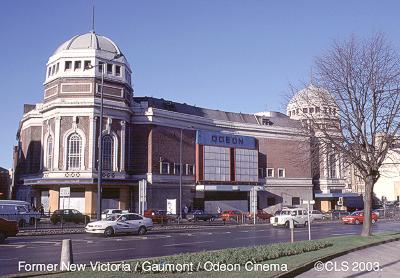 Quick Links to other sections on this page . . .
In Part 2 - The Odeon Film Centre Era 1969 to 2000
The Birth of the New Victoria Designed by local architect William Illingworth FRIBA, of Sunbridge Road, also a Bradford alderman, its twin green-domed entrances and imposing façade have been a city landmark for over seventy years. It is claimed to have used some two million bricks and a thousand tons of steel in its complex construction and is a fine example of Flemish Bond brickwork with supports in white terra-cotta. The Italian Renaissance design of its interior adapted to modern (1930) requirements and sumptuous furnishings were to be marvelled at for the next four decades. The company behind this ambitious project was Provincial Cinematograph Theatres (PCT) and Gaumont British Picture Corporation (GBPC). At the time of its construction it was to be the third largest cinema auditorium in England after the Trocadero at Elephant & Castle and the Davis Theatre in Croydon. It remained the largest theatre/cinema building opened by the PCT circuit. A proud boast at its opening was that most of the building materials and interior furnishings were provided by Bradford (and surrounding district) firms. Almost five hundred Bradford workmen had built the magnificent theatre in only six months and another four months for fitting out internally. Unique Architecture It is known that William Illingworth had studied the designs of Filippo Brunelleschi (1377-1446) a leading figure in the development of the Italian Renaissance and his revival of classical forms of architecture based on mathematical, proportion and scientific understanding of perspective and the construction of octagonal domes as in the Cathedral of his home town of Florence, Italy. William Illingworth created a building, the very latest in cinema construction and a striking example of what was to become an internationally acknowledged theatre/super cinema to rival the classical style of the great American movie theatres. Illingworth realised the importance of providing luxury throughout of the highest technical standard in making the New Victoria the complete centre of entertainment and, unique for its time, each area adaptable for multi-purpose usage. The theatre auditorium designed for 3,500 seats was acoustically perfect for stage and classical orchestral performances. The fact that the circle and balcony were set back from the stalls with minimal overhang meant that every seat provided a perfect uninterupted view of the stage and orchestra pit; but uniquely a splendid view of the richly decorated auditorium walls, ceiling and dome. Illingworth thought it important that patrons always be aware and enjoy the spectacular and sumptuous surroundings whatever price paid for the seat. Contractors & Sub-contractors 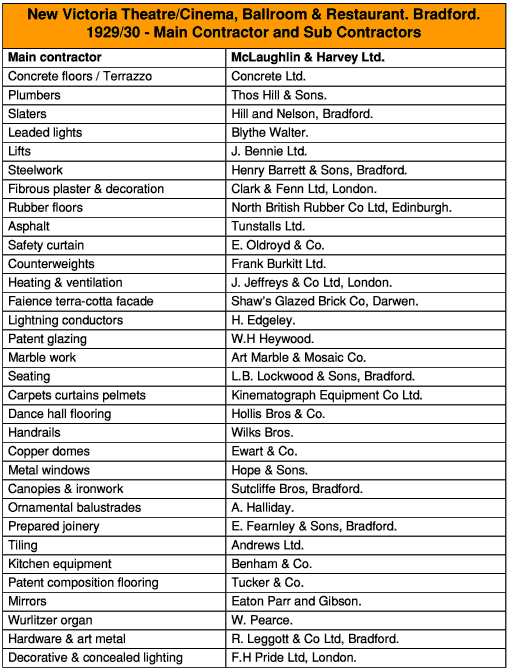 Fine Decoration The striking prscenium arch lavishly gilded with 3-tiers of concealed lighting with a choice of colours to focus the eye on the proscenium. The splay walls with columns and pilasters intercepted by beautiful grilles and lighting niches ad dignity and refinement. The gorgeous modelled dome coloured orange at the base shaded off to lemon and disappearing into a variety of sublte tints at the crown. Even the octagonal tower entrance halls were decorated in the Italian manner, with stone-lined walls and richly modelled ceilings. Octagonal Towers Afternoon teas were served in the circle café/tea lounge above the entrance at the Great Horton Road end near the Alhambra. Whilst at the Thornton Road end was a massive restaurant flanked by square pillars supporting ornate lights. First used to provide a celebration lunch on the opening day, it soon became an fashionable and elegant place to dine with attentive waitress service resplendent in their crisp black and white uniforms. Theatre Auditorium 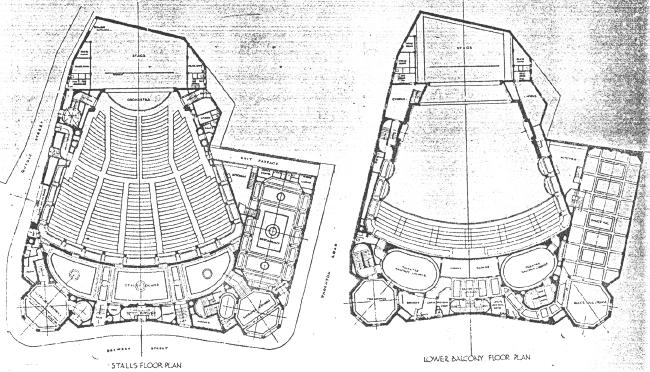 The huge proscenium opening 50 feet wide and 35 feet high with a theatre stage at 70 feet wide (including wings) and 45 feet deep with a flytower and complete with 10 dressing rooms capable of accommodating large spectacular touring shows. The New Vic, as it quickly became known, boasted a moving stage, not a rotating stage but a full width platform which moved (hand cranked) from the back to the footlights carrying a full orchestra with it. Facilities included a safety curtain, band and chorus rooms and scenery dock. The stage lighting had to be of the latest and most powerful type for a stage of this size and was installed using local labour but under the supervision of Provincial Cinematograph Theatres own Engineering Department and the Gaumont British Picture Corporation. The scheme of planning of the lighting was supervised by E.C Nicholls, AMIEE, chief engineer to the companies. 
The screen was positioned about 10 feet upstage from the footlights which meant a "throw" of almost 140 feet from the projector. As the balcony seats extended back over the projection room, it meant that the rear seats of the top balcony were 170 feet from the screen. The screen was described as an "expanding screen" (a similar screen was installed at the Rialto in Leeds around the same time) and would automatically expand and contract according to the action and was quite impressive when at its full size. The new screen was huge by 1930 standards and comprised a steel frame 50 feet wide and 30 feet high on which was mounted the pourous screen which together with its lines and counterweights weighed 2.1/2 tons. I was operated by a small switch in the projection room. All the seats in the auditorium had a clear unobstructed view of the stage and screen. The rectangular three-cove "picture frame" proscenium arch was surrounded by hundreds of coloured lights which could dissolve from one hue to another. Indeed there were so many light bulbs around the stage and the giant circular dome that it must have been a nightmare renewing them for the house electricians. Special lighting also enhanced the decorative recesses and grills which adorned the highly sculptured sides of the auditorium. The design was based on earlier Regent cinemas of the PCT group with rounded arches along the side walls of the balcony with columns extending down to the rear stalls floor. The decorative recesses in the splay walls originally housed statues and illuminated glass fountains. Almost hidden away down each side of the theatre were two self-contained flats providing accommodation for the resident manager and building engineer. An important design feature of the circle and balcony which was considered markedly different, if not unique, was the balcony being split into a front section (called the circle) and a much higher rear section (called the balcony) this arrangement effectively gave two separate circles but with quite minimal overhang. The break in height between these two sections provided the ideal position for the projection room and the back row of the circle did not feel to be in a 'pocket' under a balcony. Projection Suite The original projectors at the opening were supplied fitted with British Acoustic Sound system and the entire installation was designed to meet the exacting requirements of modern motion picture projection and capable of reproducing sound from either disc recording or film (optical) recording. British Acoustic used a special type of light sensitive selenium cell resulting in a pure and clear sound. The amplifier system produced 90-100 watts undistorted output. A switched duplicate amplifier was also fitted in case of any possible fault. Twelve moving coil loudspeakers were arranged behind the porous screen so that every part of the vast theatre was filled with sound. Later models of Kalee projectors and Duosonic sound were to be installed. Ventilation System Ceremonial Opening 1. Opening Ceremony Nothing on this scale had been seen in the provinces and the new cinema was claimed to be the largest outside London. The 'Follies of 1980' was a futuristic presentation based on half a century hence. The following week the same stage company presented the Follies of 1890 this time looking back with the costumes and music of that earlier period. As both advertisments were similar and appeared at the same time it has caused some confusion in people's memories in later years. The film in the second week was . . . "Rio Rita" - 1929 USA B/W+Technicolor 105mins. Later shows in October 1930 included a Russian Cabaret and Chinese Variety on the stage. A Royal Visit Some time later when the New Victoria had opened, the Prince of Wales returned to Bradford for another engagement (and visiting a nearby Bradford & District Unemployment Club in Quebec Street) and requested a private view of the new Theatre complex which had generated such a stir in the cinema business. He toured the building and was said to be most impressed. Wurlitzer Organ In the early years there were many broadcasts of the organ live from the theatre and in the latter years tapes have been broadcast. The BBC even thought it worthwhile to have permanent microphones and cabling to a mixer/switching desk installed for such broadcasts. The organ chambers were situated in the roof and the sound entered via the grilles above the stage providing an excellent sound in the circle and balcony but rather weak in the stalls. Additionally there was a time delay in the sound coming back to the organist with the result that it was rather difficult for the organ to actually accompany the orchestra unless amplification was used.
The Ballroom The lofty ballroom of 450 square yards with decorative pillars, mirrored walls and ornate ceiling with art-deco chandeliers. It boasted a sprung maple "Valtor" floor installed by Hollis Bros & Co. The spring mechanism (by Francis Morton Jnr & Co) was capable of being 'locked' into a rigid state when being used for other purposes. The mirrored walls with lunettes connecting wall and ceiling striking a modern note with a colour scheme of rose, oatmeal and gold. The fully equipped ballroom stage with music provided by The New Victoria Melody 5 and later by the hugely popular Billy Hey and His Band who was to enjoy a 22 years residency here. From the opening two dance sessions were held daily - the afternoon "Thé Dansant" (tea dance) at 2/- and the evening "Dîner Dansant" (dinner dance) at 3/- and 5/- on Saturday nights making this one of the most popular venues in the city for many years. During the war on the late evening of Saturday, 31st August 1940, Hitler's Luftwaffe bombed Bradford destroying many buildings including Lingards departmental store, Rawson Market and many more buildings. The nearby Odeon was badly damaged. Meanwhile in the New Victoria Ballroom dancing was in progress when the first bombs dropped and the thud was felt. The band stopped playing only momentarily then continued with the dancers continuing their 'jitter-bugging' for some time while the raid was in progess. There was no war damage to the building. Over the years the Ballroom played host to many visiting bands and concerts including Bert Bentley and His Orchestra and Benny Netherwood and the Wool City Jazzmen; in fact, many jazz sessions were held here. A resident disc-jockey was Dal Stevens (Derek Lister) of the Dal and Dadio rock 'n' roll duo. There were many private hirings of the Ballroom by leading local companies and organisations who booked their own big name orchestras and performers and as they were private bookings their names were not publicly advertised. Highlights of the winter 'dancing season' were the Panto-Press Balls run by the Water Rats and the local Nation Union of Journalists. The first Press Ball to be held in the New Victoria Ballroom was on Thursday 9th October 1930 with tickets (including dinner) at 7/6d in aid of Press Charities. The Gaumont Ballroom, as it was now known, finally closed on Saturday 30th December 1961 when Bert Bentley and His Orchestra played the last waltz and DJ Dal Stevens brought the evening to an end with the last record Dan Gibson's "Sea of Heartbreak". The Restaurant Decorated in the modern French manner with primrose, lime green and gold to create an atmosphere of "eternal spring". Walls and ornate plaster ceiling were highlighted by a huge glass pane chandelier plus suspended smaller units of similar design. Matching uplighters surrounded the tops of the square pillars adding a distinctive note. A polished wood and carpeted grand staircase connected directly with the Ballroom above. The restaurant was capable of accommodating over 200 diners and soon became a fashionable and elegant place to eat with attentive waitress service resplendent in their crisp black and white uniforms. At the opening of the theatre/cinema, a celebration lunch was provided here; thereafter a typical 4-course luncheon cost 2/6d or just 3-courses for 2/-. Both table d'hôte and à la carte menus were available also High Teas and Suppers. 1946 City Floods Damage Cinema The front stalls, orchestra pit and under-stage facilities were all below street level and flooded. Quick thinking by a member of staff and raising the organ console to its full height saved the valuable instrument from any serious damage. However carpets, seating and items stored under the stage were destroyed. Films continued to be shown with the audience in the rear stalls, circle and balcony for several days until the front stalls had been cleaned up and dried out. The 'tidemark' showing the level of the flood water was visible for many weeks on the side walls. The films showing at this time were . . . "Theirs is the Glory" - 1946 USA B/W 82mins. By contrast, across the city, the Ritz Cinema in Broadway also suffered on the same day with flooding to its entire stalls area and totally destroying the Compton organ console which could not be raised in time and so rendering it beyond repair. Thereafter the New Victoria/Gaumont remained the only city centre cinema to have a working theatre pipe organ. Saturday Morning Childrens' Club The stage was frequently used for visiting 'acts' - musical, dance and acrobatic together with the Wurlitzer organ and a singalong to words shown on the screen. The Gaumont British Junior Club had its own theme song . . . We come along on Saturday morning After 1950 when the cinema was renamed, the fifth line was changed to 'As members of the Gaumont Club'. The song was written by Con Docherty, a Rank circuit organist and a film version complete with bouncing ball on the screen was sometimes used. [A Short distance away, the Odeon had its own rival Odeon National Cinema Club (ONCC) and used the same song with line 5 'As members of the ONCC'.] The stalls area of the cinema had some 2,000 seats but the Junior Club were allowed only to sit in the front stalls area. One exception was the week following the city centre floods of 20th September 1946 when the centre section of the rear stalls was used. The fron stalls had been underwater for several hours and was still drying out with the 'tide mark' still to be seen on the side walls. Gaumont Name and Refurbishment 21st Birthday Celebrations The New Victoria/Gaumont acoustics had to be also suitable for stage and concert hall musicalal performances for which it had been often praised by leading European musicians and singers. In addition to films and organ there was a 'Birthday Queen' competition on stage and a personal appearance by new British rising star Joan Rice to cut the birthday cake. The photograph shows G.W. Ridler (manager) on the left with Joan Rice cutting the celebration cake. Spectacular Stage Shows Throughout the 1950's as the Gaumont and into the 1960's stage shows were revived on an occasional basis with great success. The Gaumont in the 50's was the largest indoor concert venue in the north of England and its excellent acoustics made it very easy to work and quickly became the first choice of singers and performers on tour, for example . . . In December 1952 for week it was "Babes in The Wood on Ice" with a touring mobile ice rink 40 feet wide and 35 feet from front to back providing 1400 square feet of 2 inches thick skating surface. The refrigeration plant was in a door recess outside in Quebec Street. Week commencing Monday 29th June 1953 was a twice nightly "Colossal attraction - Only appearance in Yorkshire prior to London Palladium engagement. America's greatest stage, film and recording entertainer Billy Daniels and his old black magic singing style with Benny Paine at the piano. The shows and classical concerts included such names as the London Symphony Orchestra under Leopold Stokowski, London Festival Ballet (May 1952), the colourful spectacle of Antonio and his Spanish Ballet, another touring Ice Spectacular with a portable ice rink. In 1954 the Gaumont Theatre played host to Italian operatic tenor Benjamino Gigli who filled the huge auditorium with his fine voice without the use of a microphone - a magnificent performance and testimony to the wonderful acoustics of this fine theatre. Weekend concerts brought the big names of the era to Bradford and included Bill Haley and the Comets (17 Feb 1957), Count Basie, Paul Anka, Yma Sumac, the very young Helen Shapiro, Frankie Lane (19 Oct 1953), Buddy Holly (9 Mar 1958) and Tom Jones (1968). Perhaps the most famous of them all were the Beatles - John, Paul, George and Ringo - brought the much publicised Beatlemania to town only to be followed later by the Rolling Stones and the hysteria which surrounded them. With names like this it was becoming a common site to see over 3000 people spilling out of the Gaumont after the first performance whilst another 3000+ waited outside to get in for the second performance. Bradford will never see the likes of that spectacle again or hear over 3000 people stamping their feet and screaming with delight - enough to shake the theatre to its foundations. To give you an example of value for money, back on 30th January 1960 the Gaumont boasted "Two sensational American Stars in Person - First time ever in England" - it was Gene Vincent backed by the Fabulous Wildcats and Eddie Cochran along with Vince Eager and an all star supporting company at ticket prices ranging from 3/6d to 7/6d (38p). Four months later Cochran was killed in a car crash. On 19th October 1963 it was The Everley Brothers with Bo Diddly and The Rolling Stones in support. The Rolling Stones returned on 4th October 1965 this time top of the bill. Throughout this period two outstanding theatre managers became household names, they were Gilbert W. Ridler (Uncle 'Phil'), a beloved and dedicated showman who managed the New Vic/Gaumont for 27 years from its opening. He was followed by John S.G. Philcox who continued to bring top names to the city. The Beatles at the Gaumont The Beatles returned to the Gaumont on Saturday 21st December 1963 headlining two sell-out performances of the pre-London Beatles Christmas Show where they included Roll over Beethoven, All My Loving, This Boy, I wanna be your Man, She Loves You, Till there was You, I want to hold your Hand, Money and Twist and Shout. The Wurlitzer organ console in the orchestra pit was boarded over for safety but this only served to provide a means for some fans to attempt to scramble onto the stage. Supporting on the same bill were Barron-Knights, Tommy Quickly, Fourmost, Billy J. Kramer and the Dakotas, Cilla Black and Rolf Harris. In 1964 the Beatles did only one UK tour which, like the previous two, began in Bradford at the Gaumont. It was on Friday 9th October 1964 and John Lennon's 24th birthday and whilst in the Beatles dressing room (on the Thornton Road side of the building) he autographed the wall with "John Lennon was here 9 Octbr 1964" (sic). This particular tour was to cover 27 venues around the UK in only 32 days. The group were paid 850 GBP for playing two houses. The set consisted of Twist and Shout, Money, Can't buy me Love, Things we said Today, I'm happy just to dance with You, I should have known better, If I Feel, I wanna be your Man, A Hard Day's Night, and Long Tall Sally. Supporting acts included The Rusticks, Michael Haslem, Bob Bain (comedian), Sounds Incorporated, Mary Wells, Tommy Quickly and the Remo Four. Prices were from 10/6d to 17/6d - quite expensive in those days. CinemaScope A new tubular frame for the screen was fitted with motorised masking to change between simple 'widescreen' and true CinemaScope aspect ratios and all controlled from the projection room. The full width movable stage platform which traversed from the back to front of stage was removed at this time. The new CinemasScope screen and its steel frame was too heavy to be 'flown' up, so it was mounted on rollers with securing bolts. It could then be unbolted and moved to the back of the stage and double as a cyclorama background for stage shows and then moved back by hand to its new postiion behind the stage tabs for films. The three stereo loudspeaker units were wheeled off into the wings during stage shows. Anamorphic lenses were fitted to the Kalee projectors but the impact of the wide screen was not quite as impressive to the spectator as could be seen later in some of the smaller cinemas. Perhaps the huge fan-shaped auditorium did not do justice to the new screen format. From Tuesday 2nd February 1954 For the record the old Odeon in Manchester Road followed with CinemaScope in March 1954 and the Essoldo (former Regent) in June 1954. 1968 Decline and Closure The Gaumont closed its doors on 30th November 1968 - a sad end to an exciting era of entertainment in the city. The final film in this vast auditorium was . . . "Rio Conchos" - 1964 USA Color de Luxe 107 mins.Since the New Victoria started life in 1930 and through the Gaumont period there have been a succession of different managers but none have been so popular as G.W. 'Phil' Ridler (previously he had been manager at the Electric Theatre in Halifax) and joined the New Victoria for its opening and to be followed by John S.G Philcox. Other at the helm included Dave Spary, Sidney Ramsey, David Wilmott, Peter Davies and Charles Close. The building was closed for nine months for conversion into 2 smaller cinemas and a bingo hall. Please read Part 2 - The Odeon Film Centre Era 1969 to 2000 for the continuing history. May not be copied or reproduced without permission.
|
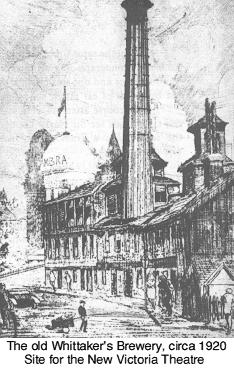 Built on the site of the old William Whittaker's brewery which had ceased brewing and malting in June 1928 and following the curve of Brewery Street. This stunning red brick theatre combined with cinema, ballroom, restaurant and tea room café. Costing a quarter of a million Pounds to build, its Moorish style Citadel frontage contrasted with the similarly domed Alhambra Theatre next door.
Built on the site of the old William Whittaker's brewery which had ceased brewing and malting in June 1928 and following the curve of Brewery Street. This stunning red brick theatre combined with cinema, ballroom, restaurant and tea room café. Costing a quarter of a million Pounds to build, its Moorish style Citadel frontage contrasted with the similarly domed Alhambra Theatre next door.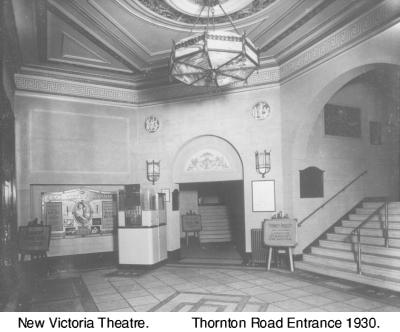 The octagonal cinema entrances were originally under the domed towers at each end of the building spanning Brewery Street (afterwards renamed New Victoria Street and nowadays Prince's Way). Connecting the two entrances was the sweeping curve of the stalls foyer or crush hall with its polished brass barriers, potted palms, huge settees, mirrors and an ornate marble fireplace midway down its huge length. The panels between the pillars were covered with a rich damask paper with a pattern copied from an original Italian Damask. Circle and balcony patrons also had ornate mirrored and carpeted lounges for queuing. Lifts were provided adjacent to each lobby for speedy access to the top balcony.
The octagonal cinema entrances were originally under the domed towers at each end of the building spanning Brewery Street (afterwards renamed New Victoria Street and nowadays Prince's Way). Connecting the two entrances was the sweeping curve of the stalls foyer or crush hall with its polished brass barriers, potted palms, huge settees, mirrors and an ornate marble fireplace midway down its huge length. The panels between the pillars were covered with a rich damask paper with a pattern copied from an original Italian Damask. Circle and balcony patrons also had ornate mirrored and carpeted lounges for queuing. Lifts were provided adjacent to each lobby for speedy access to the top balcony.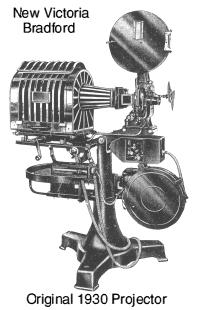 The spacious projection suite at the rear of the circle housed three Kalee film projectors (most cinemas usually only had two), lantern slide projector used for showing large glass slides with song words for audience to sing along with the organist. There were also two carbon-arc spotlights for stage shows and picking out the featured organist. The British Acoustic Sound (BAC) system installed for the opening had twelve loudspeakers around the acoustically perfect auditorium producing a "pure and clean" sound. The suite of rooms included office, store rooms, rewind room and a large battery room providing emergency power for evacuation during any interruption to the mains power supply.
The spacious projection suite at the rear of the circle housed three Kalee film projectors (most cinemas usually only had two), lantern slide projector used for showing large glass slides with song words for audience to sing along with the organist. There were also two carbon-arc spotlights for stage shows and picking out the featured organist. The British Acoustic Sound (BAC) system installed for the opening had twelve loudspeakers around the acoustically perfect auditorium producing a "pure and clean" sound. The suite of rooms included office, store rooms, rewind room and a large battery room providing emergency power for evacuation during any interruption to the mains power supply.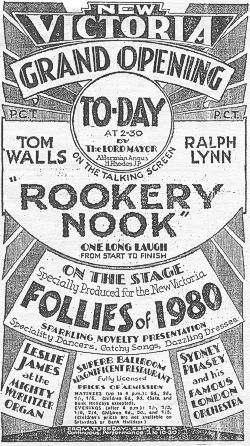 The spectacular afternoon opening performance at 2-30pm on Monday 22nd September 1930 comprised by the Lord Mayor, Alderman Angus R. Rhodes in the company of other distinguished guests, civic officials and managers of other Bradford city centre cinemas.
The spectacular afternoon opening performance at 2-30pm on Monday 22nd September 1930 comprised by the Lord Mayor, Alderman Angus R. Rhodes in the company of other distinguished guests, civic officials and managers of other Bradford city centre cinemas.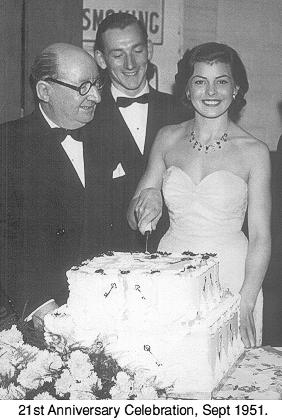 During the week following Saturday 22nd September 1951, the Gaumont celebrated its 21st 'Coming of Age' birthday and boasted that as the New Victoria it was "the first cinema in Britain to be built to the requirements of talking pictures". This was a reference to the fact that it was purpose designed to have proper acoustics for talkie films whereas other cinema halls often had dreadful acoustics which had to be modified.
During the week following Saturday 22nd September 1951, the Gaumont celebrated its 21st 'Coming of Age' birthday and boasted that as the New Victoria it was "the first cinema in Britain to be built to the requirements of talking pictures". This was a reference to the fact that it was purpose designed to have proper acoustics for talkie films whereas other cinema halls often had dreadful acoustics which had to be modified.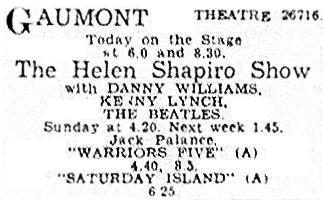 The Beatles first played the Gaumont on Saturday 2nd February 1963 but only as a 'bottom of the bill' support act to 16-year old star Helen Shapiro with her No 1 hit in 1961 "Walking Back to Happiness". This was the first tour for both Shapiro and the Beatles following their debut appearance in TV's Thank Your Lucky Stars. Before the UK tour ended the Beatles had become stars and their 'Please, Please Me' became a hit record. The Beatles also performed Chains, Keep Your Hands of My Baby and A Taste of Honey on that night when Beatles history really took off. I was fortunate to be present in the stalls on that evening.
The Beatles first played the Gaumont on Saturday 2nd February 1963 but only as a 'bottom of the bill' support act to 16-year old star Helen Shapiro with her No 1 hit in 1961 "Walking Back to Happiness". This was the first tour for both Shapiro and the Beatles following their debut appearance in TV's Thank Your Lucky Stars. Before the UK tour ended the Beatles had become stars and their 'Please, Please Me' became a hit record. The Beatles also performed Chains, Keep Your Hands of My Baby and A Taste of Honey on that night when Beatles history really took off. I was fortunate to be present in the stalls on that evening.